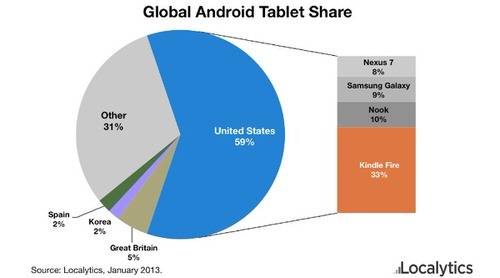
When Amazon latched onto to Android in 2011 to run its new Kindle Fire tablets, the idea made a lot of sense. Amazon didn’t have to do the grunt work of making its own operating system and could tap into a burgeoning ecosystem of mobile developers building apps for the platform.
Over the last couple of years, Amazon has been trying to galvanize Android developers to bring their apps over to the Appstore for Android so they will be available on the Kindle Fire. Amazon has done this by giving developers tools to monetize and promote their apps, launching a potentially lucrative “free app of the day” program (that has experienced its fair share of problems in the past) and promising that their apps would be discoverable on the Kindle Fire.
In its quest to rein in more developers and more apps, Amazon announced today that three-quarters of Android apps it tested will run on the Kindle Fire as is, with no additional coding required.
A Fork Less Taken
That announcement is Amazon’s effort to remind everyone that while it “forked” Android for its own purposes, it is still essentially the same Android that runs on tablets and smartphones from other manufacturers like Samsung or LG. The 2012 crop of Kindle Fire tablets employ Android 4.0.3 Ice Cream Sandwich (at API level 15).
Amazon does strip some of the features of Android for its Kindle Fire devices to customize to hardware requirements or restraints, but at heart it’s still basic Android. (Excepting that Amazon has stripped out all Google capabilities in Android from the operating system, including the browser, Google apps like Maps or Gmail and access to the Google Play Store.)
Amazon has created its own “launcher” program that sits over the operating system like a skin. The difference between this launcher (also known as a skin) and one from another manufacturer like Samsung is that users can’t easily change it without doing some technical heavy lifting. A customized launcher is almost exactly what Facebook did with its ill-fated “Home” product earlier this year, except that Facebook allows users to toggle back to a stock Android experience underneath Home. With the Kindle Fire, it’s all Amazon, all the time.
Yet This Fork Has Prongs
So, if Amazon has forked the operating system but still using the basic properties of Android, why doesn’t its Appstore have a 100% acceptance rate? Amazon lists six reasons which are all fairly common to an Appstore that pre-screens apps before publishing them.
From Amazon’s developer blog:
- App functionality doesn’t match the product description. We’ve found that this is the top reason.
- For apps designed to run on phones, the app loses state or data when it receives a message or phone call. The app should preserve its state when receiving or placing text messages and phone calls.
- The icons don’t match. Sometimes, the icons submitted in the developer portal don’t match the icons included in the application. They need to match.
- App stability or failure to launch. One in 20 of the app failures is stability related. For example, because the SD card path is not necessarily the same for all devices, assumptions about the SD card path can cause failures. Another common example is failing to include referenced libraries.
- Not replacing unsupported APIs with the Amazon equivalent API.
- Security. One example we’ve seen is writing plain-text login credentials to the log. Apps need to be secure for customers.
Reason No. 5 has a comical undertone as it alludes to the fact that Amazon doesn’t want apps in its Appstore using Google’s Android APIs (hence, sending information back to Google). Other than changing the APIs from Amazon to Google, it seems that most Android apps can be sent to Amazon with little to no additional resources put into it to adhere to the Kindle Fire.
Amazon’s biggest problem when trying to attract developers actually has nothing to do with portability or the volume of apps in its Appstore. It’s sales. Amazon is notorious for not publishing its volume of Kindle sales and that goes double for its Fire tablets. Developers follow the eyeballs, and right now the eyeballs are on iPads and Apple’s App Store and Android devices that can access Google Play.
If Amazon were to come out and say, “we have sold 50 million Kindle Fires” or some other impressive number, it would be go a long way in attracting developers to its Appstore.

According to numbers from analytics firm Localytics in January, the Kindle Fire has 33% of the Android tablet market in the United States. That’s much higher than the Barnes & Noble Nook, which takes second place with 10%.









